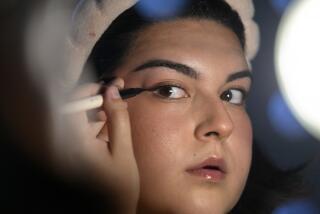Video app Vine’s popularity is spreading, six seconds at a time
- Share via
Marsha Collier was in the middle of an online chat a couple of weeks ago when her boyfriend, Curt Buthman, unexpectedly messaged her with a link. She clicked on it, opening an endlessly repeating six-second video plea, “Marsha, I love you so much. Will you marry me, please, please?”
Collier had just been “Vined” through a new video-sharing application that’s sprouted to worldwide popularity since launching nearly five months ago.
Twitter, Facebook and YouTube have all become mediums for infusing age-old traditions, such as marriage proposals, with a modern twist. But tens of millions of Vine users say the six-second vignettes, shot on Apple and Android devices, capture emotions better than text, photographs or drawn-out videos.
“He didn’t even know it was going to work,” Collier said of Buthman’s gamble. “But I thought his Vine was just six seconds of love.”
Vine is still a novelty for many of its users, who take silly videos and send them to friends for fun. But as it spreads, Vine has also become a new forum for entertainment and a serious business tool. And in another sign it’s not just a fad, Facebook on Thursday is expected to unveil a rival feature.
The Vine videos, or Vines, are being used to showcase products, including apartments, dresses, magazines and video games. Up-and-comers in Hollywood have attracted large followings by creating films and video jokes. Celebrities, chefs, journalists, sports teams and fashion houses are using it to share their everyday experiences in a captivating way.
Users start and stop a video recording with a tap on an app downloaded to a smartphone or tablet. This stitching feature lets users create visual illusions or tell a quick multi-scene story. Users say sharing on Vine is quicker than uploading video to YouTube. Like a Twitter post limited to 140 characters, the constraint of six seconds also compels users to think more creatively.
Buthman’s proposal involved his holding an iPhone in front of his face, but Collier said he prepared and even started over once.
“I don’t think it’s something you can do at the drop of your hat,” said Collier, author of “Social Media Commerce for Dummies.”
Vine’s 13 million users collectively share at least 1 million videos each day, according to analytics firm Simply Measured. Vine reached those figures four times faster than the photo-sharing app Instagram, which Facebook bought for $1 billion last April.
Twitter purchased Vine for $30 million last October, launching the smartphone application on iPhones in January and on Android smartphones this month. Hundreds of the most frequent users share 30 to 50 Vines on Twitter each week, according to analytics firm Topsy.
Christina Bauer of Long Beach downloaded the Android version as soon as it hit the market. She said a Vine is more than just a short video clip.
“It’s a bunch of images put together in a really interesting way,” she said. “It’s kind of like a turbocharged Instagram.”
Los Angeles-based actor and writer Johnno Wilson said he traded video jokes with friends through Snapchat, an instant messaging application that destroys content after it’s viewed. When friends found jokes funny, Wilson regretted being unable to share them publicly. He’s now making funny Vines to build a following and boost his “cred” among casting directors.
“It’s something more than just going into casting offices and auditioning,” he said.
Vine, co-founded by New York-based entrepreneurs Rus Yusupov, Dom Hofmann and Colin Kroll, launched a year ago on an invite-only basis. The team tested several video lengths, from about four seconds to 10 seconds, before deciding that six was the sweet spot for both producers and consumers.
After Twitter purchased it and publicly released it, the service initially drew criticism for featuring pornographic videos. All Vine videos are public and can be shared on other websites. Users can scroll through the Vine app to view popular posts or only recent ones from friends. To counter the porn issue, Vine put in place some protections, including allowing access only to iPhone and iPad users older than 16.
Though users can link their Twitter account to Vine, the two applications are separate.
But it’s that connection to Twitter, and the unique start-stop video-shooting feature, that quickly gave Vine wider recognition than its competitors such as Cinegram (four seconds), Echograph (five seconds), Viddy (30 seconds), Keek (36 seconds) and Socialcam (unlimited).
By May, 11% of iPhone users had become active users of Vine, according to the tracking company Onavo Insights. That made it one of the fastest-growing apps in Apple’s App Store, though still far behind 3-year-old Instagram’s 36% usage rate.
Vine is tapping into the fast-growing mobile video market that is attracting the attention of advertisers. Analysts say Vine is too young to worry about revenues, though it could someday leverage Twitter’s sales and engineering prowess.
“There are a lot of imitators and also-rans in this space already,” said Chris Silva, mobile industry analyst for Altimeter Group. “What makes Vine unique is the big data science Twitter can provide.”
Communication experts say Twitter makes fans feel closer to celebrities and brands. Now, they say Vine is letting fans get even closer.
“When you see a brand on Twitter, you don’t know if it’s really legit,” said Yosef Solomon, a social media consultant in Los Angeles. “Vine gives brands an opportunity to go behind the scenes and prove themselves.”
Last month, San Francisco Giants outfielder Hunter Pence spent 15 minutes answering nearly a dozen questions posed to him by fans on Twitter. He responded to each question with a six-second Vine video.
“The response online was pretty phenomenal,” said Giants social media manager Bryan Srabian.
The competition to outdo the best Vines is growing. Some people are restarting dozens of times to make their Vines perfect. Others are hiring professional filmmakers to make Vines.
Among the standout videos have been: a Super Mario parody by artist Marlo Meekins, scenes with actor Adam Goldberg’s blond wig, a scan of a dressing room by Harry Styles of the band One Direction, a series about actor Ryan Gosling refusing to eat cereal and a sad sketch of a dozen eggs under siege.
Many companies are experimenting with Vine.
Home improvement chain Lowe’s is using Vine to demonstrate tips, such as placing a rubber band over a damaged screw to help twist it out. Rolling Stone teased a magazine cover on Vine. Retailer Urban Outfitters won praise for its Vines, including beer bottles kneeling down to a beer can for Beer Can Appreciation Day.
Experts say Vine’s early success in getting users to “like” and share the branded entertainment is a good sign for the start-up.
But Vine still faces many challenges. Its simplicity could be thwarted if it yields to user demands for more features, namely privacy settings, video filters and other editing tools. A clone by YouTube or Facebook could stunt user growth. And fewer than 1 in 10 smartphone users shares videos.
Until this week, Bauer had been following her friends on Vine through videos they shared on Twitter. Those Vines included complaints about frizzy-hair days and shots of cupcakes. Bauer plans to regularly post videos of her parrot, an African Grey who loves to say funny things.
“Twitter was so cool compared to Facebook,” she said. “Then Instagram came, and now Vine is the thing to do.”
More to Read
Inside the business of entertainment
The Wide Shot brings you news, analysis and insights on everything from streaming wars to production — and what it all means for the future.
You may occasionally receive promotional content from the Los Angeles Times.











